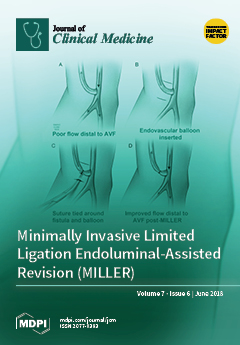Aims: The PR domain containing 16 (
PRDM16) gene and the Phosphodiesterase 4D (
PDE4) gene are both an essential regulators in the thermogenesis process in the brown adipose tissues (BAT). The influence of polymorphisms in those genes on obesity and
[...] Read more.
Aims: The PR domain containing 16 (
PRDM16) gene and the Phosphodiesterase 4D (
PDE4) gene are both an essential regulators in the thermogenesis process in the brown adipose tissues (BAT). The influence of polymorphisms in those genes on obesity and blood lipids profile is unknown particularly in the Saudi population, so the current study is aiming to explore that. Methods: A case control format was used that involved 89 obese individual and 84 non-obese (control). The
PRDM16 (
rs2651899) and
PDE4D (
rs295978) polymorphisms were genotyped using KASP™ (Competitive Allele-Specific PCR) method. Results: The distributions of the AA, GG, and AG genotypes of
PRDM16 (
rs2651899) polymorphism were 0.19, 0.26 and 0.54, respectively. While the distribution of the mutated allele A was 0.7 in the obese group comparing to 0.34 in the non-obese group. Participants with the mutated genotypes, AA and AG, of
PRDM16 (
rs2651899) polymorphism were significantly more likely to be obese as compared to participants with wild type genotype (OR = 21, 95% CI = 5.4190 to 84.4231,
p value < 0.0001 and OR = 44.6, 95% CI = 11.5984 to 172.0157,
p value < 0.0001, respectively). The wild type GG genotype of this polymorphism was associated with higher blood cholesterol, HDL and LDL but lower blood triglyceride compared with the mutated genotypes (
p = 0.003,
p = 0.008,
p = 0.02 and
p = 0.003, respectively). In contrast,
PDE4D (
rs295978) polymorphism was not associated with risk of obesity and had no effects on blood lipids profile. Conclusions: We found that the PRDM16 polymorphism (
rs2651899) is a risk factor for obesity and influence blood lipids profiles significantly in Saudi population. While the
PDE4D (
rs295978) polymorphism didn’t show significant effect on risk of obesity or blood lipids profiles.
Full article






